Characterization of Thermal Transport in One-dimensional Solid Materials
Summary
The TET (transient electro-thermal) technique is an effective approach developed to measure the thermal diffusivity of solid materials.
Abstract
The TET (transient electro-thermal) technique is an effective approach developed to measure the thermal diffusivity of solid materials, including conductive, semi-conductive or nonconductive one-dimensional structures. This technique broadens the measurement scope of materials (conductive and nonconductive) and improves the accuracy and stability. If the sample (especially biomaterials, such as human head hair, spider silk, and silkworm silk) is not conductive, it will be coated with a gold layer to make it electronically conductive. The effect of parasitic conduction and radiative losses on the thermal diffusivity can be subtracted during data processing. Then the real thermal conductivity can be calculated with the given value of volume-based specific heat (ρcp), which can be obtained from calibration, noncontact photo-thermal technique or measuring the density and specific heat separately. In this work, human head hair samples are used to show how to set up the experiment, process the experimental data, and subtract the effect of parasitic conduction and radiative losses.
Introduction
The TET technique1 is an effective approach developed to measure the thermal diffusivity of solid materials, including conductive, semi-conductive or nonconductive one-dimensional structures. In the past, the single wire 3ω method2-4 and the micro-fabricated device method5-9 have been developed to measure the thermal properties of one dimensional structures at the micro/nanoscale. In order to broaden the measurement scope of materials (conductive and nonconductive) and improve the accuracy and stability, the transient electro-thermal (TET) technique has been developed for characterization of thermophysical properties of micro/nanoscale wires. This technique has been used successfully for thermal characterization of free-standing micrometer-thick Poly (3-hexylthiophene) films10, thin films composed of anatase TiO2 nanofibers11, single-wall carbon nanotubes1, micro/submicroscale polyacrylonitrile wires12, and protein fibers. After eliminating the effect of parasitic conduction (if the sample is coated with a layer of gold to make it electronically conductive) and radiative losses, the real thermal diffusivity can be obtained. Then the real thermal conductivity can be calculated with a given value of volume-based specific heat (ρcp), which can be obtained from calibration, noncontact photo-thermal technique, or measuring the density and specific heat separately.
Protocol
1. Experiment Procedure
- Collect sample. In this work, the human head hair samples are collected from a 30-year old healthy Asian female.
- Suspend the sample between two copper electrodes as shown in Figure 1A. Apply silver paste at the sample-electrode contact to reduce the thermal and electrical contact resistances to a negligible level.
- Use a microscope to do the preliminary check of the sample and make sure that the silver paste does not contaminate the suspended sample.
- Since human head hair samples are not electrically conductive, coat the outside of the sample with a very thin layer of gold film (~40 nm) to make it electrically conductive.
- Put the sample in the vacuum chamber and pump it to 1-3 mTorr.
- Feed a step dc current through the sample to introduce electrical heating and the induced voltage-time (V–t) profile will be recorded by using an oscilloscope.
- Get the sample out of the chamber and coat it with another thin layer of gold film (~40 nm), and repeat steps 1.5 and 1.6.
- Prepare a new sample with a different length, and repeat steps 1.2-1.7.
- Use scanning electron microscope (SEM) to characterize the length and diameter of the samples (long and short ones).
2. Data Processing
Normalize the experimental temperature rise first, and conduct the theoretical fitting of that by using different trial values of the thermal diffusivity of the sample. This procedure is discussed in Guo's work1 in detail. Then subtract the effect of radiative losses and parasitic conduction on thermal diffusivity, and calculate the thermal conductivity. Details are given below.
- Determine the effective thermal diffusivity
A schematic of the TET experiment setup is shown in Figure 1A. In the measurement, feed a step current through the sample to induce joule heating. Use an oscilloscope to record the induced voltage-time (V–t) profile which is presented in Figure 1B. How fast/slow the temperature increases is determined by two competing processes: one is the joule heating, and the other one is the heat conduction from the sample to the electrodes. A higher thermal diffusivity of the sample will lead to a faster temperature evolution, meaning a shorter time to reach the steady state. Therefore, the transient voltage/temperature change can be used to determine the thermal diffusivity. When determining thermal diffusivity of the sample, no real temperature rise is needed. In fact, only the normalized temperature rise based on the voltage increase is used. The processes for determining the thermal diffusivity and thermal conductivity are outlined below.- Simplify the heat transfer to one-dimensional: Take the heat transfer of the sample in one dimension along the axial direction. Note: The length of the wire must be much longer than its diameter. More details can be referred to Guo's work1.
- Solve for the normalized temperature rise (T*, also known as the spatial average temperature over the whole sample) over the sample for a one-dimensional heat transfer problem using the following equation:
 (1)
(1)
α and L are the thermal diffusivity and length of the sample. - Solve for the normalized temperature rise from the voltage evolution (Vwire) recorded by the oscilloscope, and conduct data fitting to determine the thermal diffusivity. The voltage over the wire is related to its temperature as:
 (2)
(2)
R0 is the resistance of the sample before heating, I the current passing through the sample, and k thermal conductivity. q0 is the electrical heating power per unit volume. It is clear that the measured voltage change is inherently related to the temperature change of the sample. The normalized temperature rise T*exp based on the experimental data can be calculated as T*exp = (Vwire – V0) / (V1 – V0), where V0 and V1 are the initial and final voltages across the sample (as illustrated in Figure 1B). After obtaining T*exp, use different trial values of α to calculate the theoretical T* by applying Equation 1 and fit the experimental results (T*exp). MATLAB is used for programming to compare the experimental and theoretical values by applying the least square fitting technique, and take the value giving the best fit of T*exp as the thermal diffusivity of the sample.
- Solve for the normalized temperature rise (T*, also known as the spatial average temperature over the whole sample) over the sample for a one-dimensional heat transfer problem using the following equation:
- Simplify the heat transfer to one-dimensional: Take the heat transfer of the sample in one dimension along the axial direction. Note: The length of the wire must be much longer than its diameter. More details can be referred to Guo's work1.
- Subtract the effect of radiative losses and gas conduction
During TET thermal characterization, the effect of radiative losses could be significant if the sample has a very large aspect ratio (L/D, D: sample diameter), especially for samples of low thermal conductivity. Also if the pressure of the vacuum chamber is not very low, the heat transfer to the air will affect the measurement to some certain extent. The heat transfer rate of radiation from the sample surface can be expressed as:
 , (3)
, (3)
where ε is the effective emissivity of the sample, As the surface area, T the surface temperature, T0 the temperature of the environment (vacuum chamber), and θ = T–T0. In most cases, θ << T0, then:
 (4)
(4)
By converting the surface radiation and gas conduction to body cooling source, the heat transfer governing equation for the sample becomes:
 , (5)
, (5)
where h is the coefficient of gas conduction. In our physical model, since the electrodes are much larger than the sample and have excellent heat conduction, the sample's temperature is taken at room temperature at the contact. Because θ (x, t) = T (x, t)-T0, the boundary condition is θ (0, t) = θ (L, t) = θ (x, 0) = 0.
The solution to Equation 5 is:
 (6)
(6)
Here f is defined as -(16εδT03 / D+4h / D)L2 / π2k, which is dimensionless. It is a type of Biot number whose size indicates the amount of heat loss from the sides of the sample. Integrate this equation along the x-direction and the average temperature can be obtained:
 (7)
(7)
So the normalized average temperature is:
 (8)
(8)
After careful numerical and mathematic study, with αeff =α (1-f ), T* can be approximated as
 (9)
(9)
Numeric calculations have been conducted to study the accuracy of the above approximation. Please note that, when f is less than 0, the maximum absolute difference in the whole transient state is less than 0.014 (shown in Figure 2). Finally:
 (10)
(10)
Because the experiment is conducted in vacuum chamber at very low pressure (1-3 mTorr), the gas conduction effect (h) is negligible. So simplify Equation 10 as:
 (11)
(11)
This equation demonstrates that the measured thermal diffusivity using the TET technique has a linear relation with the effect of radiative losses (4εσT03). Use such theoretical background to subtract the effect of radiative losses and gas conduction. - Determine real thermal diffusivity and conductivity
The determined thermal diffusivity (α) in Equation 11 still has the effect of parasitic conduction if the tested sample is coated with a thin gold film. The thermal transport effect caused by the coated layer can be subtracted using the Wiedemann-Franz law with negligible uncertainty. The real thermal diffusivity (α) of the sample is determined as1:
 , (12)
, (12)
ρcp is volume-based specific heat, which can be obtained from calibration, noncontact photo-thermal technique or measuring the density and specific heat separately. LLorenz, T, and A are the Lorenz number, sample's temperature and cross-sectional area, respectively.
Because , it is apparent that αeff has a linear relationship with 1/R, so in the experiment, coating one sample with gold film twice (which will cause the change of 1/R) and testing twice can eliminate the effect of parasitic conduction by curve fitting. For real thermal conductivity k, it can be easily evaluated by using k =ρcpα.
, it is apparent that αeff has a linear relationship with 1/R, so in the experiment, coating one sample with gold film twice (which will cause the change of 1/R) and testing twice can eliminate the effect of parasitic conduction by curve fitting. For real thermal conductivity k, it can be easily evaluated by using k =ρcpα.
Representative Results
Fitting of the experimental data for human head hair sample 1 (length 0.788 mm, coated with gold film only once) is shown in Figure 3. Its thermal diffusivity is determined at 1.67 x 10-7 m2/sec, which includes the effect of radiative losses and parasitic conduction. Figure 4 is a typical SEM image of human head hair. The short and long samples are coated with gold film twice and tested twice, respectively, based on Equation 12, the effect of parasitic conduction can be easily subtracted by curve fitting as shown in Figure 5. The point where the fitting curve intersects with the αeff-axis is the value of αeff when the resistance is infinite, which means the effect of parasitic conduction in Equation 12 is 0. Two human head hair samples with different lengths are measured to obtain two intersects. Details about the experimental conditions and measurement results are summarized in Table 1. By combining these two points, the relationship between αeff and L2/D can be revealed. From the measured pairs of ( α1, L12 / D1 ) and ( α2, L22 / D2 ), linear extrapolation (as shown in Figure 6) is done to the point of L=0 (meaning no effect of radiative losses), and thermal diffusivity at that point is 1.42 x 10-7 m2/sec [=α1 – (α1–α2 ) * L12 / D1 / (L12 / D1–L22 / D2) ]. This value reflects the thermal diffusivity of the sample without the effect of radiative losses and parasitic conduction.
For human head hair, the density is characterized by weighting several strands of hair and measuring their volume, and is measured at 1,100 kg/m3. The specific heat is measured by using DSC (Differential Scanning Calorimetry) and is measured at 1.602 kJ/kg K. So the real thermal conductivity is 0.25 W/m K. Details of experimental parameters and results for human head hair sample 1 and 2 are shown in Table 1.
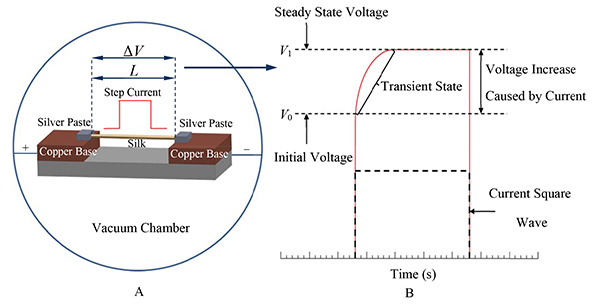
Figure 1. A) schematic of the TET experiment setup and B) a typical V–t profile. Click here to view larger image.
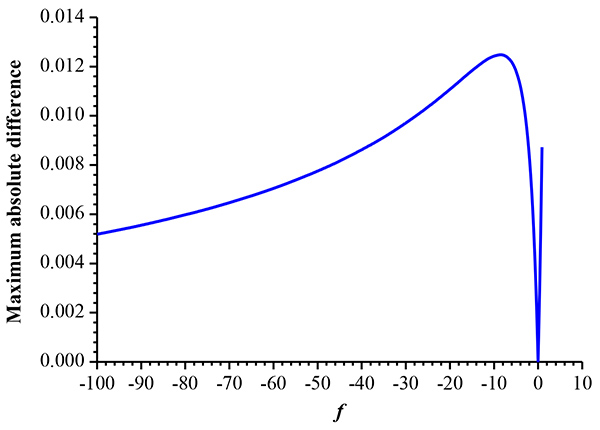
Figure 2. The difference between T* and its approximation using Equation 9. Click here to view larger image.
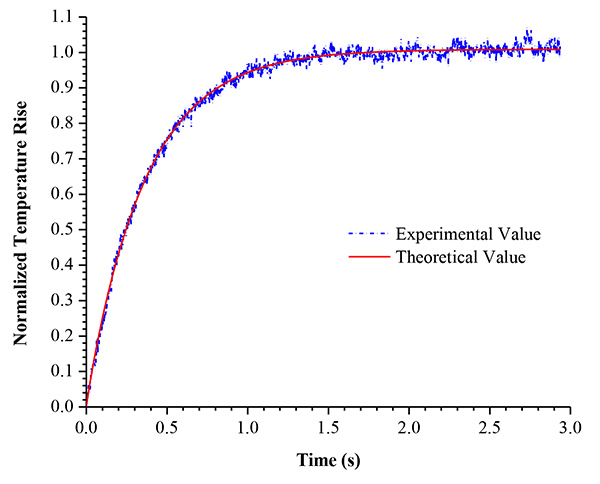
Figure 3. Comparison between the experimental data and theoretical fitting result for the normalized temperature rise versus time (human head hair sample 1). Click here to view larger image.
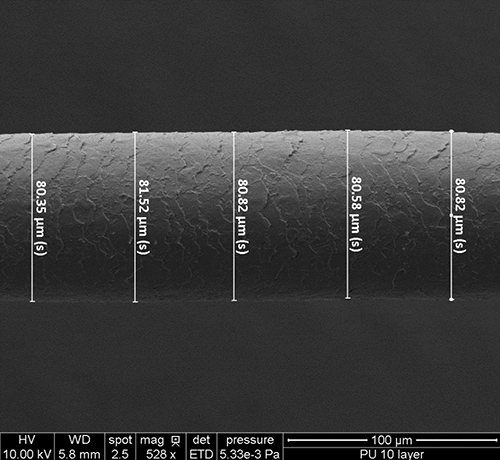
Figure 4. A typical SEM image of human head hair. Click here to view larger image.
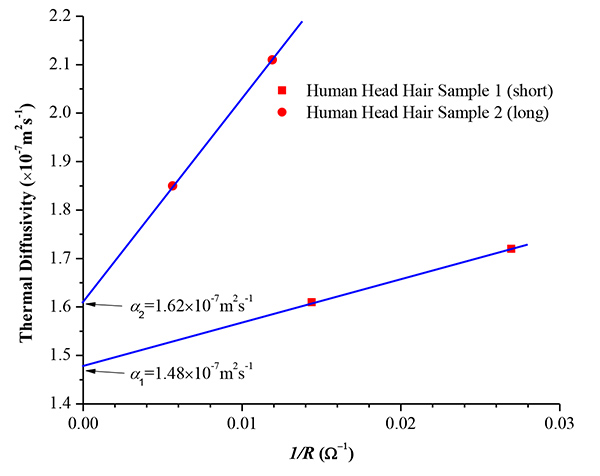
Figure 5. The fitting results for the thermal diffusivity change against 1/R for the human head hair sample 1 and 2. Click here to view larger image.
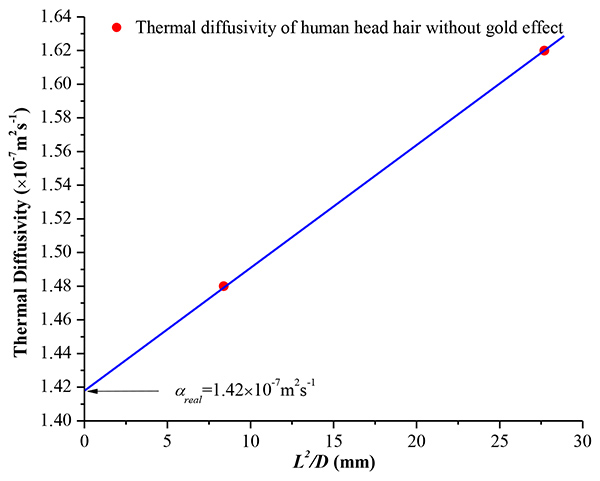
Figure 6. The fitting result for the real thermal diffusivity of human head hair samples. Click here to view larger image.
| Human head hair samples | Sample 1 (short) |
Sample 2 (long) |
| Length (mm) | 0.788 | 1.468 |
| Diameter (mm) | 74.0 | 77.8 |
| αreal+radiation (x 10-7 m2/sec) | 1.48 | 1.62 |
| αreal (x 10-7 m2/sec) | 1.42 | |
| ρcp (x 106 J/m3 K) | 1.76 | |
| Real thermal conductivity (W/m K) | 0.25 | |
Table 1: Details of experimental parameters and results for human head hair.
Discussion
In the experiment procedure, three steps [step 2), 3) and 5)] are very critical for the success of characterizing thermal properties accurately. For step 2) and 3), much attention needs to be paid on applying silver paste only at the sample-electrode contact. It is very easy to contaminate the suspended sample with silver paste, and the thermal properties will increase if this happens. So in step 3), check the sample with microscope carefully, if any contamination-the silver paste is applied or extended to the suspended sample-is noticed, a new sample needs to be prepared for the experiment.
When Equation 10 is simplified to Equation 11, it is assumed that the experiment is conducted in a vacuum chamber at very low pressure (1-3 mTorr), so the gas conduction effect is negligible. After doing a series of test at different pressures, it is confirmed that, in Equation 10, the gas conduction coefficient h is proportional to the pressure p as h=γp. The coefficient γ is related to a parameter called thermal accommodation coefficient that reflects the energy coupling/exchange coefficient when the gas molecules strike the material surface. γ can be calculated as ξπ2DρcP / (4L2) where ξ is the slope of the thermal diffusivity against pressure. γ varies from sample to sample. This gas conduction factor can be strongly affected by the material surface structure and the spatial configuration in the chamber during TET characterization. For step 5), conducting the experiment at very low pressure (1-3 mTorr) will make sure that this complicated gas conduction effect is negligible.
Surface emissivity (ε) of the samples measured by this technique can also be calculated with the given value of volume-based specific heat (ρcp), which can be obtained from calibration, noncontact photo-thermal technique13-15 or measuring the density and specific heat separately. After subtracting the effect of parasitic conduction, the thermal diffusivity (αreal+rad) shown in Figure 6 only has the effect of radiative losses,  . It is easy to know that:
. It is easy to know that:
 (13)
(13)
Here T0 is the room temperature, L the diameter of tested samples, and D the diameter of the sample.
There are several limitations of the TET technique. First, the characteristic time ∆tc for the thermal transport in the sample, which equals to 0.2026L2/α1, should be much larger than the rise time (about 2 µsec) of the current source. Otherwise, the accuracy of the voltage evolution will be affected significantly. So it requires that the sample length L should not be too small or the thermal diffusivity α should not too big. Second, the temperature of the sample will rise by about 20-30° in the experiment. Within this range, the resistance of the sample should have a linear relationship to temperature. That is because in the part of theoretical background, it is known that the measured voltage change is inherently related to the temperature change of the sample. If the resistance of the sample does not have a linear relationship to temperature, the voltage evolution cannot stand for the temperature evolution. Third, the voltage of the sample should have a linear relationship to the DC current fed during the experiment. This means at a certain temperature, the resistance will not change when the DC current changes. It is well known that semiconductors do not have this property.
In conclusion, the TET technique is a very effective and robust approach to measuring the thermal properties of various types of materials. For the same material, just test two samples with different length each twice, all the important thermal properties of the materials, such as thermal diffusivity, thermal conductivity, and surface emissivity (if ρcp is given), can be characterized.
Divulgazioni
The authors have nothing to disclose.
Acknowledgements
Support of this work from Office of Naval Research (N000141210603) and the Army Research Office (W911NF1010381) is gratefully acknowledged. Partial support of this work from the National Science Foundation (CBET-0931290, CMMI-0926704, and CBET-0932573) is also acknowledged.
Materials
| Digital Phosphor Oscilloscope | Tektronix | DPO 3052 | |
| Sputter Coater | Denton Vacuum | DESK V | |
| AC and DC Current Source | KEITHLEY | Model 6221 | |
| Laboratory Microscope | Olympus | BX41 | |
| Dual Stage Rotary Vane Vacuum Pump | Varian | DS102 | |
| Vacuum Chamber | Huntington Mechanical Laboratories | Customized Product | The pressure in the chamber should be as low as 1-3 mTorr when working with the vacuum pump |
| Colloidal Silver Liquid | Ted Pella | 16031 |
Riferimenti
- Guo, J. Q., Wang, X. W., Wang, T. Thermal characterization of microscale conductive and nonconductive wires using transient electrothermal technique. J. Appl. Phys. 101, (2007).
- Lu, L., Yi, W., Zhang, D. L. 3 omega method for specific heat and thermal conductivity measurements. Rev. Sci. Instrum. 72, 2996-3003 (2001).
- Choi, T. Y., Poulikakos, D., Tharian, J., Sennhauser, U. Measurement of the thermal conductivity of individual carbon nanotubes by the four-point three-omega method. Nano Lett. 6, 1589-1593 (2006).
- Hou, J. B., et al. Thermal characterization of single-wall carbon nanotube bundles using the self-heating 3-omega technique. J. Appl. Phys. 100, (2006).
- Kim, P., Shi, L., Majumdar, A., McEuen, P. L. Thermal transport measurements of individual multiwalled nanotubes. Phys. Rev. Lett. 87, (2001).
- Kim, P., Shi, L., Majumdar, A., McEuen, P. L. Mesoscopic thermal transport and energy dissipation in carbon nanotubes. Physica B Condens. Matter. 323, 67-70 (2002).
- Shi, L., et al. Measuring thermal and thermoelectric properties of one-dimensional nanostructures using a microfabricated device. J. Heat Transfer. 125, 881-888 (2003).
- Li, D. Y., et al. Thermal conductivity of individual silicon nanowires. Appl. Phys. Lett. 83, 2934-2936 (2003).
- Shi, L., et al. Thermal conductivities of individual tin dioxide nanobelts. Appl. Phys. Lett. 84, 2638-2640 (2004).
- Feng, X. H., Wang, X. W. Thermophysical properties of free-standing micrometer-thick Poly (3-hexylthiophene) films. Thin Solid Films. 519, 5700-5705 (2011).
- Feng, X., Wang, X., Chen, X., Yue, Y. Thermo-physical properties of thin films composed of anatase TiO2 nanofibers. Acta Mater. 59, 1934-1944 (2011).
- Guo, J. Q., Wang, X. W., Zhang, L. J., Wang, T. Transient thermal characterization of micro/submicroscale polyacrylonitrile wires. Appl. Phys. A Mater. Sci. Process. 89, 153-156 (2007).
- Hu, H. P., Wang, X. W., Xu, X. F. Generalized theory of the photoacoustic effect in a multilayer material. J. Appl. Phys. 86, 3953-3958 (1999).
- Wang, X. W., Hu, H. P., Xu, X. F. Photo-acoustic measurement of thermal conductivity of thin films and bulk materials. J. Heat. Transfer. 123, 138-144 (2001).
- Wang, T., et al. Effect of zirconium(IV) propoxide concentration on the thermophysical properties of hybrid organic-inorganic films. J. Appl. Phys. 104, (2008).

